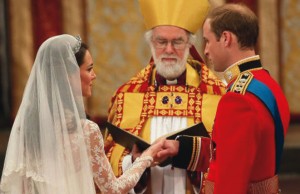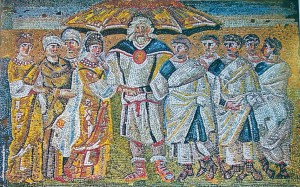The Persistence of Gesture
I am teaching a course to theology students on the Sacrament of Marriage. One of my interests is how art reflects and illustrates theology, so I showed my class the mosaic above. According to a scholar called Edwin Hall it is the earliest Christian monument to depict a marriage and is thus “the prototype for the Christian iconography of this subject.” He implies that this composition of the scene has affected directly or indirectly all portrayals and perhaps all celebrations of Christian marriage.
The mosaic is depicting the story told in Exodus chapter 2. It shows Zipporah’s sisters or handmaids, then Zipporah herself wearing her jewels and a veil, clasping the hand of Moses, as her father, Reuel unites the two of them and solemnizes their marriage. Behind Moses stand his male friends. Christian art of the fifth century would be imitating how marriage was celebrated in fifth century Rome rather than what actually happened back in the time of Moses. The historical Moses probably did not wear a toga. Christians did not invent marriage, it has existed in every culture, and details of the ceremony shown come from pagan Roman culture. The veil and the clasping of the right hands are two such details.
For Romans, the right hand was sacred to Fides, the deity of fidelity. The joining of right hands was a solemn gesture of mutual fidelity and loyalty at the end of making of an agreement or contract, the taking of an oath of allegiance, or being received into the mysteries, whose initiates were referred to as “joined by the right hand”. Christians continued this gesture, as a gesture of faith and loyalty, even though they no longer believed in a separate god of fidelity. As part of the modern Catholic marriage rite the priest says to the couple: “Since it is your intention to enter into marriage, join your right hands, and declare your consent before God and
his Church.”
 When I saw a photograph of the recent royal wedding showing the couple clasping hands before the Archbishop ofCanterbury I was struck by how conservative liturgy is; by how seemingly unimportant details persist through the centuries. The artist who produced the St Mary Major’s mosaic would have instantly recognised the photograph of a millennium and a half later as depicting a marriage. Brides still wear veils and couples still clasp right hands as they exchange their vows.
When I saw a photograph of the recent royal wedding showing the couple clasping hands before the Archbishop ofCanterbury I was struck by how conservative liturgy is; by how seemingly unimportant details persist through the centuries. The artist who produced the St Mary Major’s mosaic would have instantly recognised the photograph of a millennium and a half later as depicting a marriage. Brides still wear veils and couples still clasp right hands as they exchange their vows.
The change in the words of translation should not obscure the fact that liturgy is about doing something. What we do often matters more than the words we say.


 Entries(RSS)
Entries(RSS)